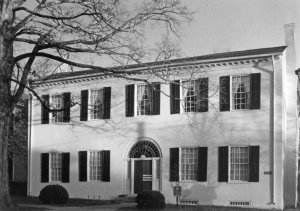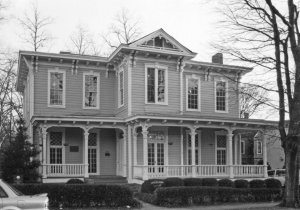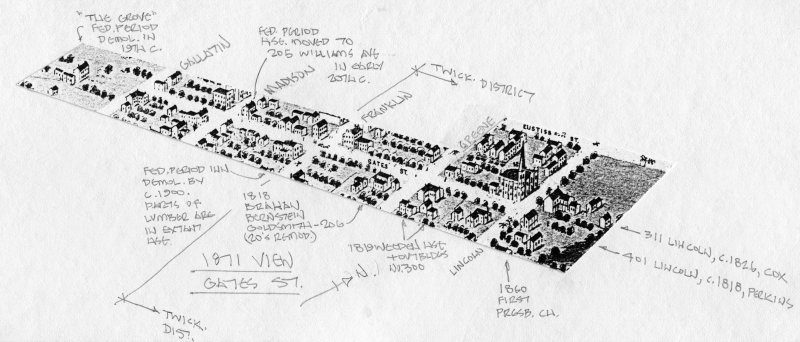


Gates Avenue consists of two blocks within the Twickenham Historic District. The 1871 View of Huntsville shows five houses and one church bordering this short stretch, of which two Federal Period houses and the 1859 First Presbyterian Church remain, along with two late-19th century houses.
The most noteworthy house is the 1819 Weeden House, now a City museum (since 1973). It is probably the most-intact Federal Period house in Huntsville. The only later elements are the back door and two mantels of the Greek Revival period. The house is also unusual in the refinement of its delicate and elaborate Federal Period trim, mantels and curving staircase. Unlike most early houses, it was built all-of-a-piece with six rooms, whereas most Federal Period houses began with two or at most four rooms in the main house, and were added to as needed. The present detached kitchen appears to date from the 1870s, per map evidence. The original two-story service building was torn down in the late 1930s for a garage (now removed). The intact foundation of the 1819 service building remains, and also photographs and measured plans and elevations of the 1930's Historic American Buildings Survey. The 1819 kitchen building is to be accurately reconstructed, perhaps in 1998.

The Weeden House was acquired for preservation by the Twickenham Historic Preservation District Association in 1973 as a fine and intact example of Federal Period architecture, and also is the home of the nationally-recognized artist and poet Maria Howard Weeden (1847-1905). The house is staffed, furnished and maintained by the Association and is open to the public as a Federal Period house museum.
The 1818-1836-1920S Brahan-Bernstein-Goldsmith house at 206 is an example of the metamorphosis of a house from one form to another, with satisfactory aesthetic results. The two-story central part shows on the 1871 View as a typical transverse gable roofed Federal Period house, with the flanking one-story 1836 pavilion rooms added at its sides, with front-facing gables. In the 1920s the roof lines were modified to give the central Federal Period part a Dutch Colonial gambrel roof and the flanking 1836 rooms were given parapeted flat roofs. The result is 1920s Dutch Colonial but it is architecturally successful. The house has a little 1920s classical-form garage in back that is charming even though it enshrines the automobile in its own tiny Roman Tuscan pilastered temple.
An excellent and unaltered example of the Italianate style is the 1883 Goldsmith house at 204 Gates Avenue. Its refined interior is almost completely intact.
The 1859 First Presbyterian Church is described in the section on Lincoln Street.
